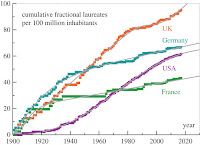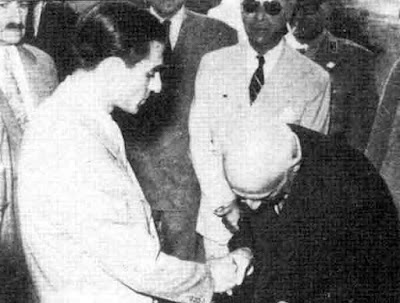Here's my pitch for the title of Megan Markle's autobiography, "Picking up a spare: My life as wife to the brother of the king."
All Posts (6505)
 |
| Comic Book dot com: Infinity War, Slide 9/11 (ominously) |
Topics: Civil Rights, Commentary, Existentialism, History, Human Rights, Science Fiction
Malthus
 |
Topics: Civics, Commentary, Existentialism, Research
Is the end in sight for US Nobel prize dominance? Culture, History and Society
Michael Allen, Physics World, Bristol, UK
 |
| Bright prospect: the first International Day of Light will be celebrated on 16 May. (Courtesy: iStock/RichLegg) |
Topics: Applied Physics, Laser, Optical Physics, Photonics
A day of light, James McKenzie, Physics World
 |
| Each universe in a multiverse contains different levels of dark energy, according to the dominant theory. STOLK/GETTY IMAGES |
Topics: Astrophysics, Cosmology, Dark Energy, Multiverses, Theoretical Physics
Multiverse theory cops a blow after dark energy findings
Andrew Masterson, Cosmos Magazine
Topics: Alternative Energy, Earthquake, Geophysics, Green Energy
Thibault Candela, Brecht Wassing, Jan ter Heege, Loes Buijze
Science
Chapter 3 for everyone to see
Head to abyssiniamedia.net and check out the REBOOT of my Comic book media company. Learned a few tricks with Word Press to make life better..... Enjoy
 |
| Mosaddegh shaking hands with Mohammad-Reza Shah in their first meeting after Mossadegh's election as Prime Minister By Unknown - http://www.aryamehr.org/eng/19august/28mordad.htm, Public Domain, https://commons.wikimedia.org/w/index.php?curid=7431651 |
Topics: Commentary, Existentialism, Politics, Star Trek
*****
 |
| A health worker walks at an Ebola quarantine unit on June 13, 2017 in Muma, Congo. Credit: John Wessels Getty Images |
Topics: Biology, Ebola, Existentialism, Politics
WHO Officials Fear Latest Ebola Outbreak in Congo Could Spread to Big Cities Helen Branswell, Scientific American
Topics: Mars, NASA, Planetary Science, Space Exploration
Spacecraft for detecting 'Marsquakes' set for rare California launch, Steve Gorman, Reuters Science
 |
| Image Source: Eureka Alert! AAAS |
Topics: Biology, Biochemistry, Bioengineering, Biomedicine
Remotely-controlled silicon structures could help treat disease, Belle Dumé, Nanotechweb.org
 |
| Alan Turing, pictured in a slate sculpture by Stephen Kettle, is known as a computer scientist and code breaker, but also made forays into mathematical biology. Credit: Steve Meddle/REX/Shutterstock |
Topics: Biology, Computer Science, Diversity in Science, Mathematical Models, Nanotechnology
Water filter inspired by Alan Turing passes first test
Membrane's structure predicted in mathematician's lone biology paper.
Mark Zastrow, Nature
#P4TC: Turing Test...June 10, 2014
IMDB: The Imitation Game
Chapter 2 Ready to view!
 |
| Mind the gap: Around 13% of last authors in physics were women – a figure that is currently increasing at a rate of just 0.1% per year (courtesy: Jarmoluk on Pixabay) |
Topics: Diversity in Science, Existentialism, Star Trek, STEM, Women in Science
Cultural reference in blog title: Waiting for Godot, by Samuel Beckett (Wikipedia)
Gender gap in physics among highest in science, Michael Allen, Physics World


